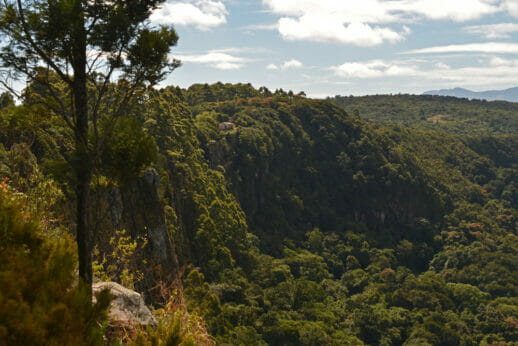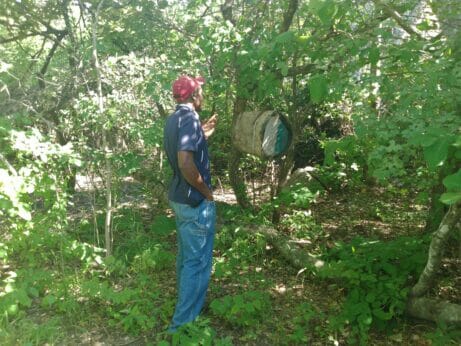Zimbabwe’s Farmers and Beekeepers Clash Over Invasive Bee Plant
In Zimbabwe, farmers and beekeepers are divided over how to handle an invasive plant choking out farmland and livestock pastures.
Zimbabwe’s Farmers and Beekeepers Clash Over Invasive Bee Plant
In Zimbabwe, farmers and beekeepers are divided over how to handle an invasive plant choking out farmland and livestock pastures.

The invasive Bee plant in Chimanimani region of Zimbabwe.by Bernard Chiketo.
As climate change pushes plant species to new areas, an invasive plant—vernonanthura polyanthes, commonly known as Bee plant—is aggressively invading Zimbabwe’s once pristine Eastern Highlands, clogging fertile croplands and livestock pastures. Farmers want the plant gone; beekeepers are celebrating the honey it produces. Neither side wants to budge. With up to 70 percent of Zimbabwe’s population working in agriculture and more than 50,000 people directly involved in beekeeping, the fight over this tall, dense plant is coming to a head.
“This plant is bad news; it’s a menace. It’s taking over fertile farmlands,” says Leonard Madanhire, a maize farmer with a 12-acre piece of land in a small farming community in the country’s Eastern Highlands, a region straddling the Zimbabwe-Mozambique border. It has prolonged rainy seasons and fertile soils, making it perfect for both livestock and orchard and row crops. From Zimbabwe’s Nyanga district in the north to Chipinge district down south, the Eastern Highlands is known for vast rich farmlands broken by lush exotic timber plantations.
The Bee plant was first spotted in eastern Zimbabwe after Cyclone Eline, which ravaged Zimbabwe and Mozambique, two decades ago. Since then, the Bee plant has invaded thousands of hectares of land, nearly taking over prime croplands, grazing lands and wildlife parks along the country’s eastern border area.
Experts say the Bee plant was introduced in neighbouring Mozambique’s Sussundenga district by beekeepers to boost honey production during the winter months. Since the plant blooms in the winter, when most other foliage sheds its leaves, it provides a food source to bees when there are few or no flowers from other plants.
But small-scale crop and livestock farmers in the area are at their wits’ end as the invasive Bee plant chokes out their land. Farmers in areas such as Vumba, Burma Valley, Chimanimani and Chipinge have tried to use machetes and axes to clear the plant with little or no success.
“Farmers don’t even know what to do with the plant. I think experts should come up with chemicals to destroy it. Yes, we hear the plant is good for honeybees, but we can’t all eat honey only,” says Madanhire.
Farmers in the region acknowledge the importance of bees for pollination. But beekeepers and farmers remain oceans apart regarding what should be done to control the invasive plant.
Farmers and environmentalists are lobbying the government to help to eradicate the plant, as it outcompetes native species and can be a threat to crop fields, timber plantations, tea farms, orchards and tourism resorts in the Eastern Highlands.

Amid deafening calls by farmers and environmentalists to totally eradicate the Bee plant from the Eastern Highlands, Ishmael Sithole, a beekeeper in Zimbabwe’s Manicaland province, instead blames some farmers in the region for poor farming practices.
Sithole, who also chairs the Manicaland Apiculture Association, a group of beekeepers in the province, suggests that farmers should not leave croplands idle for two or more years. “Oftentimes, it’s those [farmers] who are not practicing good agricultural practices who complain about invasion,” he says.
Because much of the region is covered in deciduous forests, bees are at risk of starving over winter. But the Bee plant is a prolific winter bloom, so Sithole says it offers bees a much-needed source of winter food. “This then translates into a massive August-September honey flow,” says Sithole.
Sithole says honey from Bee plant flowers is much sought-after as the honey is monofloral, made from just one type of flower. As monofloral honey is more difficult to obtain than polyfloral honey, beekeepers can charge higher prices for it. Sithole says the honey has no strong or offensive smell, usually has a low moisture content, thereby posing least risk for fermentation, has a clear hue and does not stain bread and salads. “The honey does not quickly crystallize in combs after harvesting and when jarred. It poses little extraction challenges,” he says.

Bart Wursten, a botanist and principal contributor to the Zimbabwe Flora and sister websites, says the “slash and burn agriculture” practices on the Mozambique side of the border gave the plant ample opportunity to spread rapidly. He says that, although it is probably true that more stable forested habitats will give the Bee plant less chance to dominate, surrounding edges and secondary habitats will have serious infestations.
“These infestations are far more susceptible to fires, and these fires can then damage more of the stable habitats where vernonanthura will then invade and progress its cycle of invasion deeper and deeper into the indigenous habitats,” he says.
Christopher Chapano, a botanical scientist and head of Zimbabwe’s National Herbarium and Botanic Garden, adds that it is believed that the Bee plant found its way to Zimbabwe after Cyclone Eline where areas of the vegetation were left bare and gave this plant an advantage to colonize these open niches.
“The plant is wind dispersed, making it more easily spread to different ecological areas,” says Chapano.
But, he says there are methods of controlling the plant. “I have seen some people uprooting the plant because of its shallow rooting system. Others just cut the stems above the ground surface. The use of herbicides suitable for controlling this plant has to be tested to come up with the right chemical control for use by the farmers,” says Chapano.
For now, however, farmers and beekeepers remain locked in the battle over vernonanthura polyanthes, and neither side is ready to back down.
Follow us
This work is licensed under a Creative Commons Attribution-NoDerivatives 4.0 International License.
Want to republish a Modern Farmer story?
We are happy for Modern Farmer stories to be shared, and encourage you to republish our articles for your audience. When doing so, we ask that you follow these guidelines:
Please credit us and our writers
For the author byline, please use “Author Name, Modern Farmer.” At the top of our stories, if on the web, please include this text and link: “This story was originally published by Modern Farmer.”
Please make sure to include a link back to either our home page or the article URL.
At the bottom of the story, please include the following text:
“Modern Farmer is a nonprofit initiative dedicated to raising awareness and catalyzing action at the intersection of food, agriculture, and society. Read more at <link>Modern Farmer</link>.”
Use our widget
We’d like to be able to track our stories, so we ask that if you republish our content, you do so using our widget (located on the left hand side of the article). The HTML code has a built-in tracker that tells us the data and domain where the story was published, as well as view counts.
Check the image requirements
It’s your responsibility to confirm you're licensed to republish images in our articles. Some images, such as those from commercial providers, don't allow their images to be republished without permission or payment. Copyright terms are generally listed in the image caption and attribution. You are welcome to omit our images or substitute with your own. Charts and interactive graphics follow the same rules.
Don’t change too much. Or, ask us first.
Articles must be republished in their entirety. It’s okay to change references to time (“today” to “yesterday”) or location (“Iowa City, IA” to “here”). But please keep everything else the same.
If you feel strongly that a more material edit needs to be made, get in touch with us at [email protected]. We’re happy to discuss it with the original author, but we must have prior approval for changes before publication.
Special cases
Extracts. You may run the first few lines or paragraphs of the article and then say: “Read the full article at Modern Farmer” with a link back to the original article.
Quotes. You may quote authors provided you include a link back to the article URL.
Translations. These require writer approval. To inquire about translation of a Modern Farmer article, contact us at [email protected]
Signed consent / copyright release forms. These are not required, provided you are following these guidelines.
Print. Articles can be republished in print under these same rules, with the exception that you do not need to include the links.
Tag us
When sharing the story on social media, please tag us using the following: - Twitter (@ModFarm) - Facebook (@ModernFarmerMedia) - Instagram (@modfarm)
Use our content respectfully
Modern Farmer is a nonprofit and as such we share our content for free and in good faith in order to reach new audiences. Respectfully,
No selling ads against our stories. It’s okay to put our stories on pages with ads.
Don’t republish our material wholesale, or automatically; you need to select stories to be republished individually.
You have no rights to sell, license, syndicate, or otherwise represent yourself as the authorized owner of our material to any third parties. This means that you cannot actively publish or submit our work for syndication to third party platforms or apps like Apple News or Google News. We understand that publishers cannot fully control when certain third parties automatically summarize or crawl content from publishers’ own sites.
Keep in touch
We want to hear from you if you love Modern Farmer content, have a collaboration idea, or anything else to share. As a nonprofit outlet, we work in service of our community and are always open to comments, feedback, and ideas. Contact us at [email protected].by Andrew Mambondiyani, Modern Farmer
December 16, 2022
Modern Farmer Weekly
Solutions Hub
Innovations, ideas and inspiration. Actionable solutions for a resilient food system.
ExploreExplore other topics
Share With Us
We want to hear from Modern Farmer readers who have thoughtful commentary, actionable solutions, or helpful ideas to share.
SubmitNecessary cookies are absolutely essential for the website to function properly. This category only includes cookies that ensures basic functionalities and security features of the website. These cookies do not store any personal information.
Any cookies that may not be particularly necessary for the website to function and are used specifically to collect user personal data via analytics, ads, other embedded contents are termed as non-necessary cookies.
Does the Bee Plant have any value as forage? Can it be grazed by goats, sheep or other livestock? If so, grazing would be a great alternative to herbicide to keep the plant in check.
Zimbabwe has enough problem producing enough food to feed itself. Honey should be secondary.